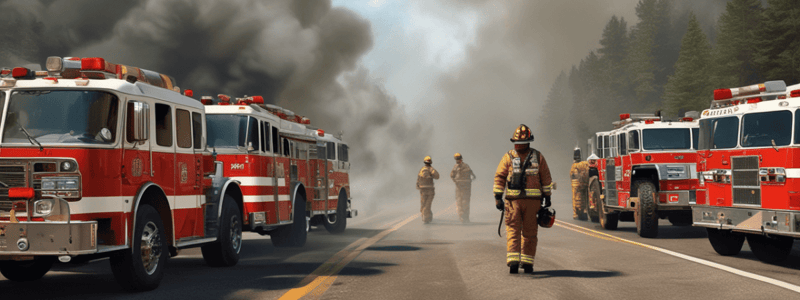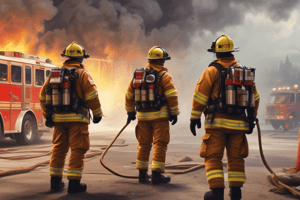Podcast
Questions and Answers
What is the primary purpose of establishing a Rapid Intervention Crew (RIC) at an incident scene?
What is the primary purpose of establishing a Rapid Intervention Crew (RIC) at an incident scene?
- To investigate the cause of the incident
- To rescue lost or missing firefighters (correct)
- To provide medical aid to civilians
- To assist in extinguishing the fire
Under what circumstances should the Incident Commander consider establishing a RIC?
Under what circumstances should the Incident Commander consider establishing a RIC?
- At all fire incidents, based on scene conditions (correct)
- Only at structure fires
- Only at hazardous materials incidents
- Only at confined space incidents
How many RICs should be established at a larger or more complex incident?
How many RICs should be established at a larger or more complex incident?
- One RIC for each side of the incident
- Multiple RICs, but only at the discretion of the Incident Commander
- One RIC for each point of entry into the building or hazard zone (correct)
- Only one RIC
What is the minimum number of RICs that should be established at an incident scene?
What is the minimum number of RICs that should be established at an incident scene?
What is NOT a scenario that would require the immediate deployment of a RIC?
What is NOT a scenario that would require the immediate deployment of a RIC?
Who is responsible for establishing the RIC at an incident scene?
Who is responsible for establishing the RIC at an incident scene?
Where can guidance on RIC be found for other types of incidents?
Where can guidance on RIC be found for other types of incidents?
What is the title of the Standard Operating Guideline (SOG) that addresses the utilization of RIC at structure fires?
What is the title of the Standard Operating Guideline (SOG) that addresses the utilization of RIC at structure fires?
What is the primary purpose of a RIC?
What is the primary purpose of a RIC?
What should a RIC do upon arrival at the fire scene?
What should a RIC do upon arrival at the fire scene?
What is the purpose of the RIC Size-Up?
What is the purpose of the RIC Size-Up?
What should the RIC Supervisor do upon arrival?
What should the RIC Supervisor do upon arrival?
What should a RIC consider for large structures?
What should a RIC consider for large structures?
What is a key aspect of the RIC's role?
What is a key aspect of the RIC's role?
What should the RIC do after completing the RIC Size-Up?
What should the RIC do after completing the RIC Size-Up?
What should a RIC be provided with during the face-to-face briefing?
What should a RIC be provided with during the face-to-face briefing?
What is the minimum number of personnel required for a Rapid Intervention Crew (RIC)?
What is the minimum number of personnel required for a Rapid Intervention Crew (RIC)?
Where should the RIC begin their search for the lost/missing/trapped firefighter(s)?
Where should the RIC begin their search for the lost/missing/trapped firefighter(s)?
If the Streamwood Fire Department responds to a Code 4 incident, which company is automatically designated as the RIC?
If the Streamwood Fire Department responds to a Code 4 incident, which company is automatically designated as the RIC?
What is the role of the Streamwood Company Officer when acting as the RIC Group Supervisor?
What is the role of the Streamwood Company Officer when acting as the RIC Group Supervisor?
What should the RIC do if hose lines of the lost firefighters are not available?
What should the RIC do if hose lines of the lost firefighters are not available?
When a MABAS Box Alarm incident occurs, which company is initially designated as the RIC?
When a MABAS Box Alarm incident occurs, which company is initially designated as the RIC?
What should the Incident Commander do simultaneously with the RIC's search and rescue efforts?
What should the Incident Commander do simultaneously with the RIC's search and rescue efforts?
If the Inverness Engine Company is unavailable for RIC duty, which type of company should be designated as a replacement?
If the Inverness Engine Company is unavailable for RIC duty, which type of company should be designated as a replacement?
What is a requirement for the Incident Commander to assign the RIC Supervisor and Safety Officer to complete a final RIC Size-Up?
What is a requirement for the Incident Commander to assign the RIC Supervisor and Safety Officer to complete a final RIC Size-Up?
What apparatus respond to a Mayday Response in a NWCD jurisdiction?
What apparatus respond to a Mayday Response in a NWCD jurisdiction?
Why should the RIC be replaced with another company if the Inverness Company is used for other tactical priorities?
Why should the RIC be replaced with another company if the Inverness Company is used for other tactical priorities?
As the size or complexity of an incident increases, how should the number of RICs be determined?
As the size or complexity of an incident increases, how should the number of RICs be determined?
What should happen to the company upon de-activation of the RIC?
What should happen to the company upon de-activation of the RIC?
When should the Incident Commander upgrade the alarm to the next higher alarm?
When should the Incident Commander upgrade the alarm to the next higher alarm?
Which of the following is NOT a potential reason for needing a Rapid Intervention Crew (RIC)?
Which of the following is NOT a potential reason for needing a Rapid Intervention Crew (RIC)?
What is the purpose of a final RIC Size-Up?
What is the purpose of a final RIC Size-Up?
What is the minimum equipment that a RIC must have for a rescue operation?
What is the minimum equipment that a RIC must have for a rescue operation?
In what situation should the RIC be deployed?
In what situation should the RIC be deployed?
What evaluation must the RIC conduct regarding hose lines?
What evaluation must the RIC conduct regarding hose lines?
What action must the Incident Commander take alongside deploying the RIC?
What action must the Incident Commander take alongside deploying the RIC?
What constitutes a catastrophic event that necessitates deploying the RIC?
What constitutes a catastrophic event that necessitates deploying the RIC?
Who primarily determines which tools the RIC should use during a rescue operation?
Who primarily determines which tools the RIC should use during a rescue operation?
When is a MAYDAY response initiated?
When is a MAYDAY response initiated?
Which of the following is NOT a situation that warrants immediate RIC deployment?
Which of the following is NOT a situation that warrants immediate RIC deployment?
Flashcards are hidden until you start studying
Study Notes
Rapid Intervention Crew (RIC) Guidelines
- The Hoffman Estates Fire Department's policy is to establish a Rapid Intervention Crew (RIC) within the Incident Management system for all fire incidents.
- The RIC's purpose is to have a designated company standing by in a state of readiness in case of a lost or missing firefighter, reported injured firefighter, catastrophic event, or other condition requiring immediate deployment of a rescue team.
Establishing the RIC
- The Incident Commander should consider the need for RIC at all fire incidents, based on scene conditions and potential risks.
- A minimum company size of three personnel is desired for a RIC.
- If RIC is required, the incident commander should request a Code 4 to get the appropriate resources.
Code 4 and MABAS Box Alarm Incidents
- Automatically at the Code 4 level, Streamwood Fire Department responds with an engine or squad company, designated as the RIC.
- The Initial Rapid Intervention Crew (IRIC) is assigned to the Streamwood Company to create a 5-6 firefighter RIC, with the Streamwood Company Officer as the RIC Group Supervisor.
- At the MABAS Box Alarm level, the Inverness Fire Department responds with an Engine Company with a minimum of three personnel and a Chief Officer, designated as the RIC.
Rescue Size-Up and Location of RIC
- The RIC reports directly to the Incident Commander, bypassing staging, and positions apparatus in close proximity to the fire scene.
- The RIC Supervisor receives a briefing and specific instructions from the Incident Commander.
- The RIC performs a building walk-around or division evaluation, known as the "RIC Size-Up", to identify:
- Safety concerns
- Need and location of second egress points
- Construction of the structure
- Building layout
- Location of crews working inside the structure
- Potential rescue apparatus placement locations
- Availability of a back-up hoseline
Tool Selection
- The RIC Size-Up provides information for the RIC Supervisor to determine the most appropriate tools for affecting a rescue of a missing, lost, or trapped firefighter.
- The RIC should be equipped with:
- Forcible entry tools
- A set of SCBA and mask (for downed firefighter)
- 100' of rescue rope
- Hand lights
- The RIC should also evaluate pre-stretched and charged hose lines for use.
Deployment of RIC
- The RIC is deployed in cases of:
- Report of lost firefighter or MAYDAY
- Report of a missing or potentially missing firefighter
- Report of a trapped firefighter(s)
- Following a catastrophic event
- The RIC is assigned to conduct search and/or rescue operations, and the Incident Commander requests a Mayday Response and initiates a PAR (roll call) of all companies assigned to the incident.
De-Activation of RIC
- When all risk factors in the hazard zone have been removed and a PAR indicates all personnel are accounted for, the Incident Commander can assign the RIC Supervisor and Safety Officer to complete a final RIC Size-Up.
- The RIC can be de-activated if the final size-up determines it is safe to do so, and the company may be returned to quarters or given a new assignment.
Definitions
- Mayday Response: a predetermined closest geographical response from NWCD for a specific set of apparatus.
Studying That Suits You
Use AI to generate personalized quizzes and flashcards to suit your learning preferences.




